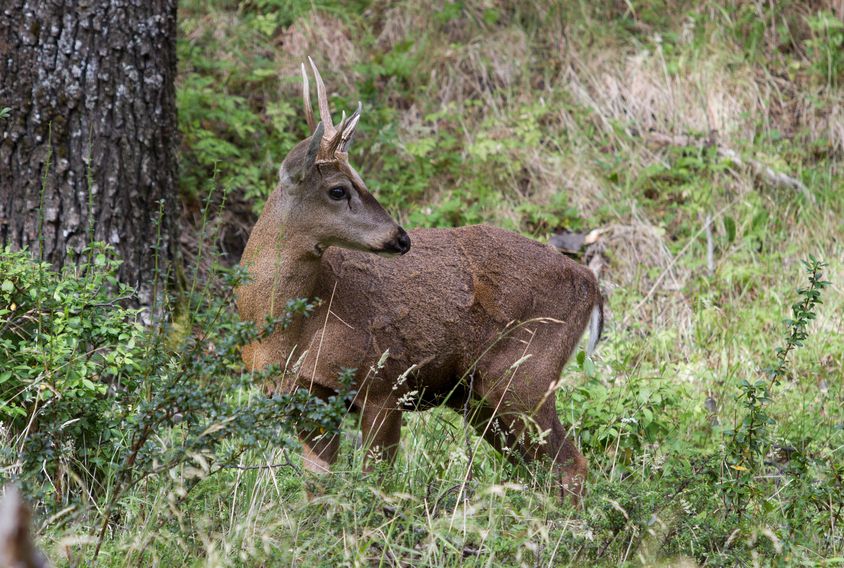Taking pride of place on the country’s coat of arms, the South American huemul is a member of the deer family and is the national animal of Chile. Alongside the national bird, the Andean Condor, it is an important species native to the Andean regions of Chile and Argentina. Once abundant in number, the past few centuries have seen populations of the South American huemul declining rapidly. Although it’s unlikely you’ll have the luck to ever spot one of these iconic creatures, here are the eight facts you should know about the Chile national animal.
1. They have a confusing range of different names
It’s easy to get confused by the Chile national animal, as it’s known by no fewer than five different names: Patagonian huemul, Chilean guemal, South Andean deer, South Andean huemul and Chilean huemul. However, don’t confuse this species of deer with the taruca, which is smaller and lighter in color, nor the southern pudú, another genus of deer which is the smallest in the world and populates southern Chile and south-western Argentina.
2. The huemul is easily recognised
Its coarse, dark brown coat and undersides that are much lighter in colour make it easily recognizable, as do its “donkey-like” ears. Males have antlers and are characterized by a dark stripe on the bridge of their nose, which appears to form a distinctive pair of eyebrows where it forks between the eyes.
3. But sightings are incredibly rare
While this big-eared species of deer is a national treasure, it’s unlikely that you, or many Chilean nationals, will ever see one. Exceptionally shy in character – something understandable given their rapid decline in numbers – you’re extremely lucky if you do spy one in the wild.
4. Patagonia offers the best chance to spot a South American huemul
Although they’re known to inhabit parts of Chile from Chillán southwards, as well as the southwestern stretch of Argentina, your best bet for seeing huemul is along the shores of Lago Cochrane and in Tamango National Reserve as Conservacion Patagonica have recently established protected habitats for this endangered species in these regions.
 Torres del Paine National Park has a 60-strong population and sightings of the deer have been recorded in recent years in Nahuel Huapi National Park in Argentina.
Torres del Paine National Park has a 60-strong population and sightings of the deer have been recorded in recent years in Nahuel Huapi National Park in Argentina.
5. Its habitat has required the species to adapt physically
The rugged, barely-hospitable terrain of the Andean mountains has required the South Andean huemul to physically adapt to the challenges of its habitat. Occupying areas from sea-level up to 5500 feet (1,700m) of elevation, it has developed short legs and a stocky build to help it climb over this rough terrain.
The coloring of its coat also enables it to blend into its surroundings, which are normally forests of southern beech or dense shrubland.
6. The Chile national animal is at risk of extinction
Although once prolific throughout the Andean region of Chile and Argentina, the population of South Andean huemul has been dwindling rapidly.
 Since 1982, it has been registered as endangered on the IUCN Red List of Threatened Species. Estimates suggest that only 1500 animals remain, two-thirds of which are thought to reside in Chile.
Since 1982, it has been registered as endangered on the IUCN Red List of Threatened Species. Estimates suggest that only 1500 animals remain, two-thirds of which are thought to reside in Chile.
7. Its predators are responsible for its rapidly declining population
Predators of the huemul include pumas, culpeo foxes and domestic dogs. However, by far its most significant predator has been humans. Since settlers arrived in Patagonia in the 19th-century, they have played a fundamental role in seriously reducing the global population of this species.
8. Protecting the South Andean huemul has finally become a priority
Argentina has faced extreme criticism for not recognising the potential threat of extinction facing the Chile national animal. It is only since 2010 that both Chile and Argentina have taken to working cooperatively to prevent the tiny population of of South Andean huemul from dwindling any further.
Measures aimed at addressing illegal hunting and habitat degradation, amongst other critical threats, have been introduced to tackle the issue, and both countries hope to bring this emblematic creature back from the brink of extinction.
No comments yet
There are no comments on this post yet.





Leave a comment